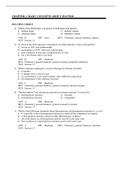Exam (elaborations)
General, Organic, and Biological Chemistry, Stoker - Complete test bank - exam questions - quizzes (updated 2022)
- Institution
- Harvard College
Description: - Test bank with practice exam questions and their answers - Compatible with different editions (newer and older) - Various difficulty levels from easy to extremely hard - The complete book is covered (All chapters) - Questions you can expect to see: Multiple choice questions, Pr...
[Show more]



